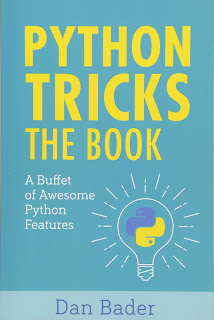Python Tricks The Book: A Buffet of Awesome Python Features
Download
Introduction
Foreword
It’s been almost ten years since I first got acquainted with Python as a
programming language. When I first learned Python many years ago,
it was with a little reluctance. I had been programming in a different
language before, and all of the sudden at work, I was assigned to a
different team where everyone used Python. That was the beginning
of my own Python journey.
When I was first introduced to Python, I was told that it was going to
be easy, that I should be able to pick it up quickly. When I asked my
colleagues for resources for learning Python, all they gave me was a
link to Python’s official documentation. Reading the documentation
was confusing at first, and it really took me a while before I even felt
comfortable navigating through it. Often I found myself needing to
look for answers in StackOverflow.
Coming from a different programming language, I wasn’t looking for
just any resource for learning how to program or what classes and
objects are. I was looking for specific resources that would teach me
the features of Python, what sets it apart, and how writing in Python
is different than writing code in another language.
It really has taken me many years to fully appreciate this language. As
I read Dan’s book, I kept thinking that I wished I had access to a book
like this when I started learning Python many years ago.
For example, one of the many unique Python features that surprised
me at first were list comprehensions. As Dan mentions in the book, a tell of someone who just came to Python from a different language
is the way they use for-loops. I recall one of the earliest code review
comments I got when I started programming in Python was, “Why
not use list comprehension here?” Dan explains this concept clearly
in section 6, starting by showing how to loop the Pythonic way and
building it all the way up to iterators and generators.
In chapter 2.5, Dan discusses the different ways to do string formatting
in Python. String formatting is one of those things that defy the
Zen of Python, that there should only be one obvious way to do things.
Dan shows us the different ways, including my favorite new addition
to the language, the f-strings, and he also explains the pros and cons
of each method.
The Pythonic Productivity Techniques section is another great resource.
It covers aspects beyond the Python programming language,
and also includes tips on how to debug your programs, how to manage
the dependencies, and gives you a peek inside Python bytecode.
It truly is an honor and my pleasure to introduce this book, Python
Tricks, by my friend, Dan Bader.
By contributing to Python as a CPython core developer, I get connected
to many members of the community. In my journey, I found
mentors, allies, and made many new friends. They remind me that
Python is not just about the code, Python is a community.
Mastering Python programming isn’t just about grasping the theoretical
aspects of the language. It’s just as much about understanding and
adopting the conventions and best practices used by its community.
Dan’s book will help you on this journey. I’m convinced that you’ll be
more confident when writing Python programs after reading it.

